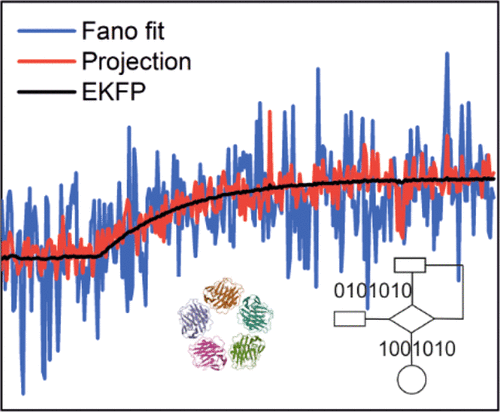Our official English website, www.x-mol.net, welcomes your feedback! (Note: you will need to create a separate account there.)
Extended Kalman Filtering Projection Method to Reduce the 3σ Noise Value of Optical Biosensors
ACS Sensors ( IF 8.9 ) Pub Date : 2020-10-27 , DOI: 10.1021/acssensors.0c01484 Kezheng Li 1 , Roopam Gupta 2, 3 , Alexander Drayton 1 , Isabel Barth 1 , Donato Conteduca 1 , Christopher Reardon 1 , Kishan Dholakia 2, 4 , Thomas F. Krauss 1
ACS Sensors ( IF 8.9 ) Pub Date : 2020-10-27 , DOI: 10.1021/acssensors.0c01484 Kezheng Li 1 , Roopam Gupta 2, 3 , Alexander Drayton 1 , Isabel Barth 1 , Donato Conteduca 1 , Christopher Reardon 1 , Kishan Dholakia 2, 4 , Thomas F. Krauss 1
Affiliation

|
Optical biosensors have experienced a rapid growth over the past decade because of their high sensitivity and the fact that they are label-free. Many optical biosensors rely on tracking the change in a resonance signal or an interference pattern caused by the change in refractive index that occurs upon binding to a target biomarker. The most commonly used method for tracking such a signal is based on fitting the data with an appropriate mathematical function, such as a harmonic function or a Fano, Gaussian, or Lorentz function. However, these functions have limited fitting efficiency because of the deformation of data from noise. Here, we introduce an extended Kalman filter projection (EKFP) method to address the problem of resonance tracking and demonstrate that it improves the tolerance to noise, reduces the 3σ noise value, and lowers the limit of detection (LOD). We utilize the method to process the data of experiments for detecting the binding of C-reactive protein in a urine matrix with a chirped guided mode resonance sensor and are able to improve the LOD from 10 to 1 pg/mL. Our method reduces the 3σ noise value of this measurement compared to a simple Fano fit from 1.303 to 0.015 pixels. These results demonstrate the significant advantage of the EKFP method to resolving noisy data of optical biosensors.
中文翻译:

扩展卡尔曼滤波投影方法可降低光学生物传感器的3σ噪声值
光学生物传感器由于其高灵敏度和无标签的事实,在过去十年中经历了快速的增长。许多光学生物传感器依赖于跟踪由与靶生物标志物结合后发生的折射率变化引起的共振信号或干涉图样的变化。跟踪此类信号的最常用方法是基于将数据与适当的数学函数拟合,例如谐波函数或Fano,Gaussian或Lorentz函数。但是,由于噪声导致数据变形,这些功能的拟合效率受到限制。在这里,我们介绍了一种扩展的卡尔曼滤波器投影(EKFP)方法来解决共振跟踪问题,并证明它提高了对噪声的容忍度,降低了3σ噪声值,并降低了检测限(LOD)。我们利用该方法来处理实验数据,以with引导模式共振传感器检测尿基质中C反应蛋白的结合,并且能够将LOD从10 pg / mL提高到1 pg / mL。与简单的Fano拟合(从1.303像素到0.015像素)相比,我们的方法降低了此测量的3σ噪声值。这些结果证明了EKFP方法在解决光学生物传感器噪声数据方面的显着优势。
更新日期:2020-11-25
中文翻译:

扩展卡尔曼滤波投影方法可降低光学生物传感器的3σ噪声值
光学生物传感器由于其高灵敏度和无标签的事实,在过去十年中经历了快速的增长。许多光学生物传感器依赖于跟踪由与靶生物标志物结合后发生的折射率变化引起的共振信号或干涉图样的变化。跟踪此类信号的最常用方法是基于将数据与适当的数学函数拟合,例如谐波函数或Fano,Gaussian或Lorentz函数。但是,由于噪声导致数据变形,这些功能的拟合效率受到限制。在这里,我们介绍了一种扩展的卡尔曼滤波器投影(EKFP)方法来解决共振跟踪问题,并证明它提高了对噪声的容忍度,降低了3σ噪声值,并降低了检测限(LOD)。我们利用该方法来处理实验数据,以with引导模式共振传感器检测尿基质中C反应蛋白的结合,并且能够将LOD从10 pg / mL提高到1 pg / mL。与简单的Fano拟合(从1.303像素到0.015像素)相比,我们的方法降低了此测量的3σ噪声值。这些结果证明了EKFP方法在解决光学生物传感器噪声数据方面的显着优势。


























 京公网安备 11010802027423号
京公网安备 11010802027423号